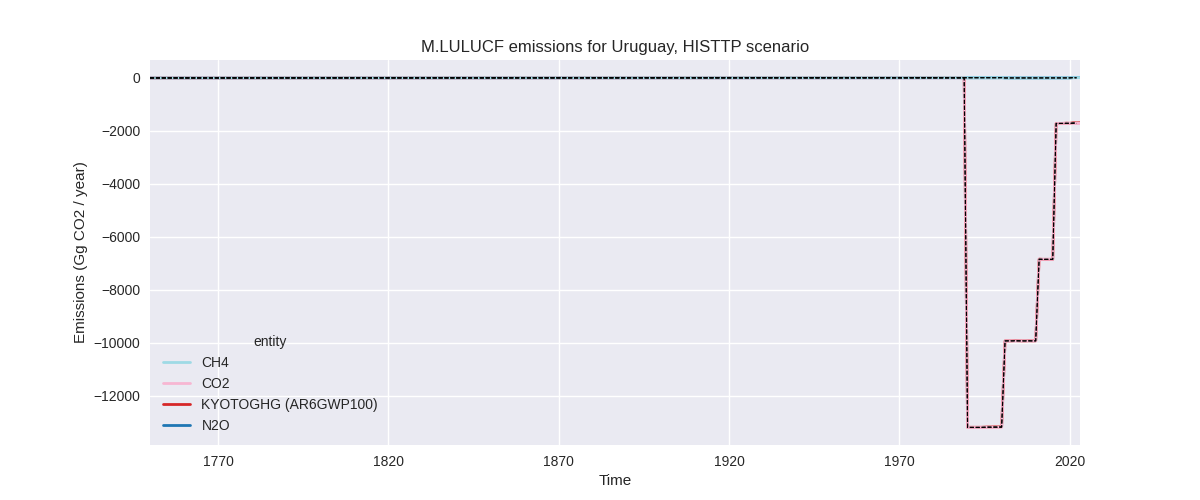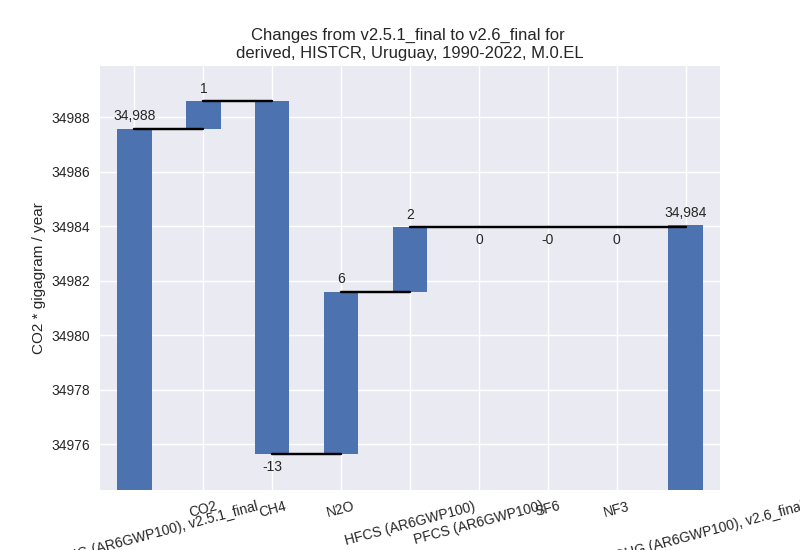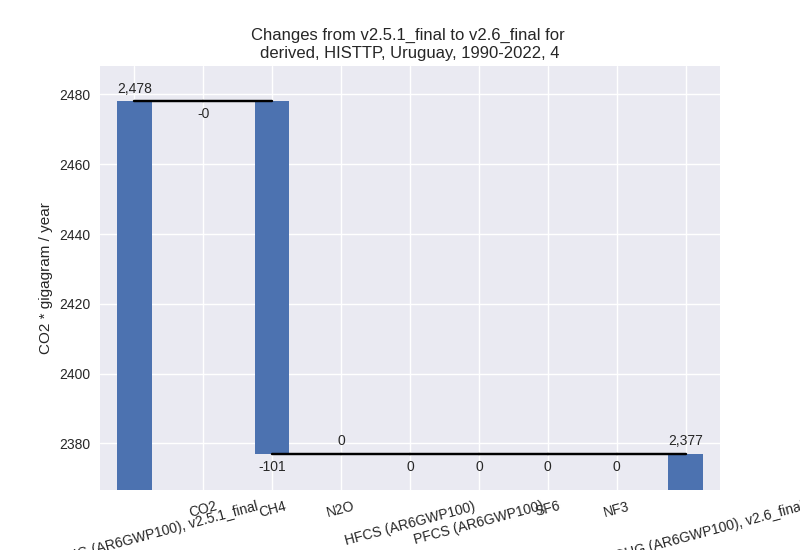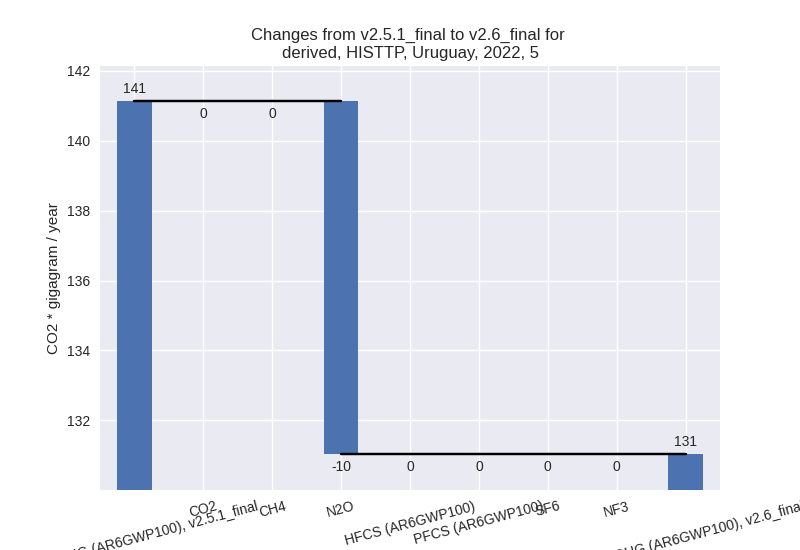Changes in PRIMAP-hist v2.6_final compared to v2.5.1_final for Uruguay
2024-09-24
Johannes Gütschow
Change analysis for Uruguay for PRIMAP-hist v2.6_final compared to v2.5.1_final
Overview over emissions by sector and gas
The following figures show the aggregate national total emissions excluding LULUCF AR6GWP100 for the country reported priority scenario. The dotted linesshow the v2.5.1_final data.



The following figures show the aggregate national total emissions excluding LULUCF AR6GWP100 for the third party priority scenario. The dotted linesshow the v2.5.1_final data.



Overview over changes
In the country reported priority scenario we have the following changes for aggregate Kyoto GHG and national total emissions excluding LULUCF (M.0.EL):
- Emissions in 2022 have changed by -1.3%% (-495.16 Gg CO2 / year)
- Emissions in 1990-2022 have changed by -0.0%% (-3.55 Gg CO2 / year)
In the third party priority scenario we have the following changes for aggregate Kyoto GHG and national total emissions excluding LULUCF (M.0.EL):
- Emissions in 2022 have changed by -3.0%% (-1376.72 Gg CO2 / year)
- Emissions in 1990-2022 have changed by -0.3%% (-123.30 Gg CO2 / year)
Most important changes per scenario and time frame
In the country reported priority scenario the following sector-gas combinations have the highest absolute impact on national total KyotoGHG (AR6GWP100) emissions in 2022 (top 5):
- 1: 1.A, CO2 with -354.00 Gg CO2 / year (-4.4%)
- 2: 4, CH4 with -157.50 Gg CO2 / year (-9.5%)
- 3: 2, CO2 with 75.44 Gg CO2 / year (14.0%)
- 4: 2, HFCS (AR6GWP100) with -40.87 Gg CO2 / year (-8.9%)
- 5: 4, N2O with -10.17 Gg CO2 / year (-14.2%)
In the country reported priority scenario the following sector-gas combinations have the highest absolute impact on national total KyotoGHG (AR6GWP100) emissions in 1990-2022 (top 5):
- 1: 2, CO2 with 26.21 Gg CO2 / year (6.8%)
- 2: 1.A, CO2 with -25.20 Gg CO2 / year (-0.4%)
- 3: 4, CH4 with -12.95 Gg CO2 / year (-1.1%)
- 4: 5, N2O with 6.67 Gg CO2 / year (9.0%)
- 5: 2, HFCS (AR6GWP100) with 2.38 Gg CO2 / year (2.8%)
In the third party priority scenario the following sector-gas combinations have the highest absolute impact on national total KyotoGHG (AR6GWP100) emissions in 2022 (top 5):
- 1: 4, CH4 with -1006.02 Gg CO2 / year (-15.1%)
- 2: 1.A, CO2 with -355.74 Gg CO2 / year (-4.4%)
- 3: 5, N2O with -10.10 Gg CO2 / year (-7.2%)
- 4: 2, HFCS (AR6GWP100) with -6.13 Gg CO2 / year (-2.6%)
- 5: 4, N2O with 1.09 Gg CO2 / year (2.1%)
In the third party priority scenario the following sector-gas combinations have the highest absolute impact on national total KyotoGHG (AR6GWP100) emissions in 1990-2022 (top 5):
- 1: 4, CH4 with -101.11 Gg CO2 / year (-4.2%)
- 2: 1.A, CO2 with -25.33 Gg CO2 / year (-0.4%)
- 3: 5, N2O with 6.67 Gg CO2 / year (9.0%)
- 4: 1.B.1, CO2 with -3.00 Gg CO2 / year (-17.0%)
- 5: 1.B.1, CH4 with -0.98 Gg CO2 / year (-30.5%)
Notes on data changes
Here we list notes explaining important emissions changes for the country. ’' means that the following text only applies to the TP time series, while means that it only applies to the CR scenario. Otherwise the note applies to both scenarios.
- Energy CO2 emissions in 2022 have changed due to the updated EI data.
- UNFCCC DI data missed sector 2.D. This has been added leading to higher IPPU CO2 emissions post 2014.
- Changes in sectors 4 and 5 are due to the removal of FAOSTAT data.
Changes by sector and gas
For each scenario and time frame the changes are displayed for all individual sectors and all individual gases. In the sector plot we use aggregate Kyoto GHGs in AR6GWP100. In the gas plot we usenational total emissions without LULUCF. ## country reported scenario
2022


1990-2022


third party scenario
2022


1990-2022


Detailed changes for the scenarios:
country reported scenario (HISTCR):
Most important changes per time frame
For 2022 the following sector-gas combinations have the highest absolute impact on national total KyotoGHG (AR6GWP100) emissions in 2022 (top 5):
- 1: 1.A, CO2 with -354.00 Gg CO2 / year (-4.4%)
- 2: 4, CH4 with -157.50 Gg CO2 / year (-9.5%)
- 3: 2, CO2 with 75.44 Gg CO2 / year (14.0%)
- 4: 2, HFCS (AR6GWP100) with -40.87 Gg CO2 / year (-8.9%)
- 5: 4, N2O with -10.17 Gg CO2 / year (-14.2%)
For 1990-2022 the following sector-gas combinations have the highest absolute impact on national total KyotoGHG (AR6GWP100) emissions in 1990-2022 (top 5):
- 1: 2, CO2 with 26.21 Gg CO2 / year (6.8%)
- 2: 1.A, CO2 with -25.20 Gg CO2 / year (-0.4%)
- 3: 4, CH4 with -12.95 Gg CO2 / year (-1.1%)
- 4: 5, N2O with 6.67 Gg CO2 / year (9.0%)
- 5: 2, HFCS (AR6GWP100) with 2.38 Gg CO2 / year (2.8%)
Changes in the main sectors for aggregate KyotoGHG (AR6GWP100) are
- 1: Total sectoral emissions in 2022 are 8037.22 Gg
CO2 / year which is 20.7% of M.0.EL emissions. 2022 Emissions have
changed by -4.2% (-354.00 Gg CO2 /
year). 1990-2022 Emissions have changed by -0.4% (-25.21 Gg CO2 / year). For 2022 the
changes per gas
are:

The changes come from the following subsectors:- 1.A: Total sectoral emissions in 2022 are 8032.71
Gg CO2 / year which is 99.9% of category 1 emissions. 2022 Emissions
have changed by -4.2% (-354.00 Gg
CO2 / year). 1990-2022 Emissions have changed by -0.4% (-25.20 Gg CO2 / year). For 2022 the
changes per gas
are:

There is no subsector information available in PRIMAP-hist. - 1.B.1: Total sectoral emissions in 2022 are 0.00 Gg
CO2 / year which is 0.0% of category 1 emissions. 2022 Emissions have
changed by 0.0% (0.00 Gg CO2 /
year). 1990-2022 Emissions have changed by -31.0% (-0.01 Gg CO2 / year). For
1990-2022 the changes per gas
are:

There is no subsector information available in PRIMAP-hist. - 1.B.2: Total sectoral emissions in 2022 are 4.51 Gg CO2 / year which is 0.1% of category 1 emissions. 2022 Emissions have changed by 0.0% (0.00 Gg CO2 / year). 1990-2022 Emissions have changed by 0.0% (0.00 Gg CO2 / year).
- 1.A: Total sectoral emissions in 2022 are 8032.71
Gg CO2 / year which is 99.9% of category 1 emissions. 2022 Emissions
have changed by -4.2% (-354.00 Gg
CO2 / year). 1990-2022 Emissions have changed by -0.4% (-25.20 Gg CO2 / year). For 2022 the
changes per gas
are:
- 2: Total sectoral emissions in 2022 are 1034.43 Gg
CO2 / year which is 2.7% of M.0.EL emissions. 2022 Emissions have
changed by 3.7% (36.62 Gg CO2 /
year). 1990-2022 Emissions have changed by 6.1% (29.05 Gg CO2 / year). For 2022 the
changes per gas
are:

For 1990-2022 the changes per gas are:
- M.AG: Total sectoral emissions in 2022 are 28028.81 Gg CO2 / year which is 72.3% of M.0.EL emissions. 2022 Emissions have changed by 0.0% (0.00 Gg CO2 / year). 1990-2022 Emissions have changed by 0.0% (0.00 Gg CO2 / year).
- 4: Total sectoral emissions in 2022 are 1557.62 Gg
CO2 / year which is 4.0% of M.0.EL emissions. 2022 Emissions have
changed by -9.7% (-167.68 Gg CO2 /
year). 1990-2022 Emissions have changed by -1.2% (-14.06 Gg CO2 / year). For 2022 the
changes per gas
are:

- 5: Total sectoral emissions in 2022 are 131.03 Gg
CO2 / year which is 0.3% of M.0.EL emissions. 2022 Emissions have
changed by -7.2% (-10.10 Gg CO2 /
year). 1990-2022 Emissions have changed by 9.0% (6.67 Gg CO2 / year). For 2022 the
changes per gas
are:

For 1990-2022 the changes per gas are:
third party scenario (HISTTP):
Most important changes per time frame
For 2022 the following sector-gas combinations have the highest absolute impact on national total KyotoGHG (AR6GWP100) emissions in 2022 (top 5):
- 1: 4, CH4 with -1006.02 Gg CO2 / year (-15.1%)
- 2: 1.A, CO2 with -355.74 Gg CO2 / year (-4.4%)
- 3: 5, N2O with -10.10 Gg CO2 / year (-7.2%)
- 4: 2, HFCS (AR6GWP100) with -6.13 Gg CO2 / year (-2.6%)
- 5: 4, N2O with 1.09 Gg CO2 / year (2.1%)
For 1990-2022 the following sector-gas combinations have the highest absolute impact on national total KyotoGHG (AR6GWP100) emissions in 1990-2022 (top 5):
- 1: 4, CH4 with -101.11 Gg CO2 / year (-4.2%)
- 2: 1.A, CO2 with -25.33 Gg CO2 / year (-0.4%)
- 3: 5, N2O with 6.67 Gg CO2 / year (9.0%)
- 4: 1.B.1, CO2 with -3.00 Gg CO2 / year (-17.0%)
- 5: 1.B.1, CH4 with -0.98 Gg CO2 / year (-30.5%)
Changes in the main sectors for aggregate KyotoGHG (AR6GWP100) are
- 1: Total sectoral emissions in 2022 are 8156.10 Gg
CO2 / year which is 18.6% of M.0.EL emissions. 2022 Emissions have
changed by -4.2% (-355.74 Gg CO2 /
year). 1990-2022 Emissions have changed by -0.5% (-29.32 Gg CO2 / year). For 2022 the
changes per gas
are:

The changes come from the following subsectors:- 1.A: Total sectoral emissions in 2022 are 8118.32
Gg CO2 / year which is 99.5% of category 1 emissions. 2022 Emissions
have changed by -4.2% (-355.74 Gg
CO2 / year). 1990-2022 Emissions have changed by -0.4% (-25.33 Gg CO2 / year). For 2022 the
changes per gas
are:

There is no subsector information available in PRIMAP-hist. - 1.B.1: Total sectoral emissions in 2022 are 0.00 Gg
CO2 / year which is 0.0% of category 1 emissions. 2022 Emissions have
changed by 0.0% (0.00 Gg CO2 /
year). 1990-2022 Emissions have changed by -19.1% (-4.00 Gg CO2 / year). For
1990-2022 the changes per gas
are:

There is no subsector information available in PRIMAP-hist. - 1.B.2: Total sectoral emissions in 2022 are 37.78 Gg CO2 / year which is 0.5% of category 1 emissions. 2022 Emissions have changed by 0.0% (0.00 Gg CO2 / year). 1990-2022 Emissions have changed by 0.0% (0.00 Gg CO2 / year).
- 1.A: Total sectoral emissions in 2022 are 8118.32
Gg CO2 / year which is 99.5% of category 1 emissions. 2022 Emissions
have changed by -4.2% (-355.74 Gg
CO2 / year). 1990-2022 Emissions have changed by -0.4% (-25.33 Gg CO2 / year). For 2022 the
changes per gas
are:
- 2: Total sectoral emissions in 2022 are 609.17 Gg CO2 / year which is 1.4% of M.0.EL emissions. 2022 Emissions have changed by -1.0% (-5.93 Gg CO2 / year). 1990-2022 Emissions have changed by 0.1% (0.35 Gg CO2 / year).
- M.AG: Total sectoral emissions in 2022 are 29323.38 Gg CO2 / year which is 66.7% of M.0.EL emissions. 2022 Emissions have changed by 0.0% (0.00 Gg CO2 / year). 1990-2022 Emissions have changed by 0.0% (0.00 Gg CO2 / year).
- 4: Total sectoral emissions in 2022 are 5721.15 Gg
CO2 / year which is 13.0% of M.0.EL emissions. 2022 Emissions have
changed by -14.9% (-1004.95 Gg CO2 /
year). 1990-2022 Emissions have changed by -4.1% (-100.99 Gg CO2 / year). For 2022
the changes per gas
are:

For 1990-2022 the changes per gas are:
- 5: Total sectoral emissions in 2022 are 131.03 Gg
CO2 / year which is 0.3% of M.0.EL emissions. 2022 Emissions have
changed by -7.2% (-10.10 Gg CO2 /
year). 1990-2022 Emissions have changed by 9.0% (6.67 Gg CO2 / year). For 2022 the
changes per gas
are:

For 1990-2022 the changes per gas are: